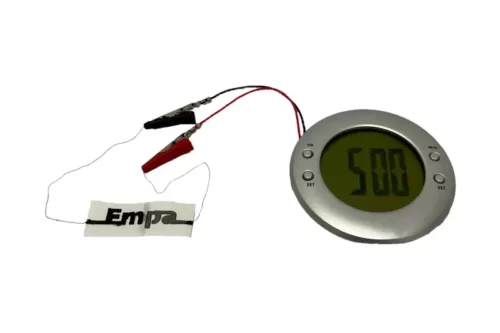A disposable paper battery to reduce the environmental impact of single-use electronics for applications such as point of care diagnosis, smart packaging, and environmental sensing.

The battery uses Zinc as a biodegradable metal anode, graphite as a nontoxic cathode material, and paper as a biodegradable substrate. The battery is fabricated without electrolyte hence when a drop of water is added, the paper itself is impregnated with salt to create an electrolyte releasing charged ions. As ions disperse they cause zinc at the anode to oxidize and release electrons.
In a lab test, a two-cell version of the battery was successfully able to power a small alarm clock with a liquid crystal display. It was found that a drop of water was enough to activate the single cell within 20 seconds. When the battery was not connected to the energy-consuming device it could produce approximately 1.2 volts. The battery performed efficiently for one hour after which its performance dropped as paper naturally dried, maintaining its operating voltage of 0.5 volts.
Gustav Nyström at the Swiss Federal Laboratories for Materials Science and Technology (EMPA) and his colleagues took a rectangular strip of paper and printed it with ink containing graphite flakes on one side to act as a cathode. On the reverse side, they are printed with ink containing zinc powder, which acts as the anode.
Nyström says the batteries could run devices that track parcels in real-time, making supply chains more efficient, or to help recycle food packaging by powering devices that provide precise information about the materials used in the packet at the end of its life.”These electrons can then be transferred from the zinc-containing anode – via the graphite- and carbon black-containing ink, the wires, and the device – to the graphite cathode where they are transferred to – and hence reduce – oxygen from ambient air,” Empa explained. “These redox reactions (reduction and oxidation) thus generate an electrical current that can be used to power an external electrical device.”
The researchers say that the amount of zinc deposited on the paper will determine the capacity of the battery and can be used for different applications. The paper and zinc are biodegradable and would also be recyclable with the right processes.
Click here for the published research paper






